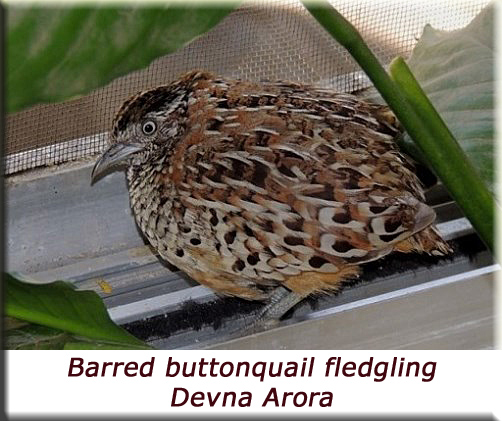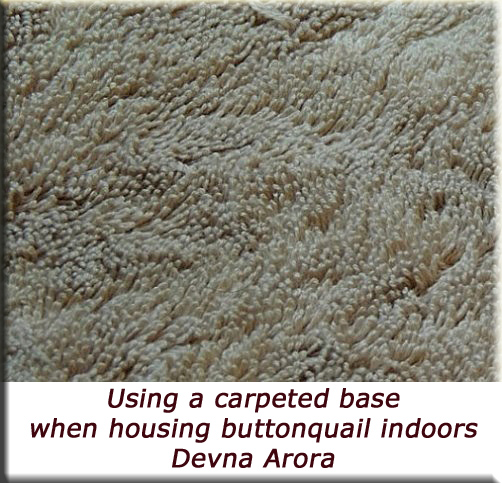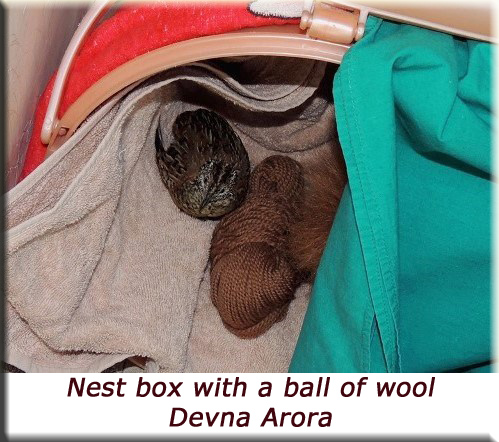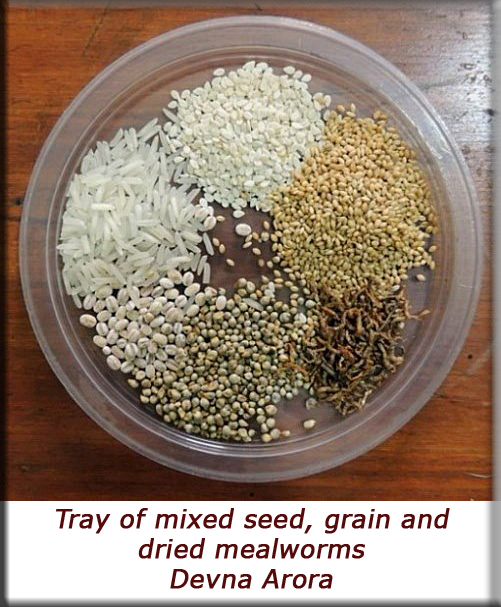Case Study: Hand-rearing a Barred Buttonquail (Turnix suscitator) fledgling
Devna Arora
This little buttonquail (Turnix suscitator) fledgling was found one morning in someone’s society in Feb 2014 – Pune, India. Attempts at reuniting the baby seemed futile since the baby was found in the city, a fair distance from any decent grass/scrubland (apart from one isolated patch nearby) and the lil’ one was taken in for hand-rearing and subsequent release.
Condition on admission
The baby bird was small, her (unsexed) body was slightly smaller than a tennis ball but she was taller if you included her legs. Wings were slightly held out much like any other fledgling and at most times, esp. when she fluffed up, the tips of her primaries would stand out distinctly.
The right wing, although absolutely functional, had suffered a mild injury or trauma as the primaries of the right wing were always a little protruded in comparison to the left wing (as seen in the pic below) – this significantly reduced over time. They were perhaps also distinctly visible due to a lack of coverts in the same patch. The right wing was also held slightly apart for the first few days (as seen in the pic when the bird is sitting in the nest box). No veterinary intervention was required as both the wing and the bird were fine otherwise.
Housing and flooring
This baby was hand-reared at home so the very first thing I did was to make an enclosure for her with a carpeted bottom so her feet don’t splay on smooth/tiled surface. I used thick Turkish towels to line the enclosure and put potted plants all around for cover. Rugs or carpets will also serve the purpose just fine but the towels were easier to maintain – washed once in every 5 days to maintain hygiene. The enclosure was filled with potted plants and divided by curtains to ensure she retains her instincts of moving in cover. I also gave her a nest-box to sleep in and kept that on the floor – the box again was lined with a thick towel and I placed a small soft toy in her box upon which she slept for the first two nights.
On the third day I placed a ball of wool (brown coloured) in her box and from then on I’d always see her sleeping next to that ball of wool. Perhaps it simulated the presence of other smaller birds of her size.
Her enclosure was next to the window so she could benefit from natural sunlight and watch the birds outside. She enjoyed watching the smaller birds and was always more active in their presence but was never too happy with the more boisterous pigeons or babblers.
Warmth
Although it was Feb, there was a cold spell when she was rescued so for the first week when it was really chilly at night, I’d place a hot-water bottle over the basket, i.e., over her nesting box, at around midnight every night for a week and cover the bottle with a couple of layers of cloth. This ensured that the basket remain just warm and comfortable through the night. The hot-water bottle was discontinued as soon as the weather was warmer.
Diet
On average, she ate every hour from sunrise to sundown. Her primary diet was about a teaspoon of millet seeds and a measured ½ teaspoon of dried mealworms every day. She also enjoyed mashed boiled egg, halved peas (just the small, sweet ones) and fresh coriander, including the flower-heads of coriander which she liked. She also occasionally consumed a bit of sesame seeds and perhaps also some grain (I always ensured she have a variety of grain and seed to choose from) but I could not quantify or assess that. Sprouted mung beans were also given to her a few times but she never appeared to consume any.
In addition to the seed and dried meal worms, I ensured she gets at least one serving of fresh green leafy vegetable and one other vegetable every day – they were consumed selectively. Grated apples and grapes were also offered but never consumed. I expect that they will enjoy other smaller seeds and seed mixes as their diet is primarily seeds of grasses.
Water: Fresh, clean drinking water, offered in shallow bowls, must be available for them at all times, more so when offering a dry diet.
Droppings
Droppings were primarily as above when on a diet of seed and fresh vegetables. I would also see the blackish droppings which looked like the ones below – this appeared to be in response to consumption of animal protein, i.e., boiled eggs and dried mealworms in her case. This is the primary reason I would ration her intake of mealworms. When given the choice, she selectively only consumed mealworms but keeping her droppings in mind, I wasn’t sure if that was ideal for her and decided to ration her intake of mealworms to ½ a teaspoon of mealworms a day: ¼ teaspoon in the morning and ¼ teaspoon in the afternoon.
Activity pattern
She was active during the day with a dip in activity when the sun was at its peak. She would go into her nest box by sunset and would become very uneasy if anyone was around her at that moment – she needed to return to her resting space without anyone watching her.
Release
She was shy and weaker initially but grew stronger, bold and a lot more active and restless over the days. Whereas she would barely lift a meter into the air upon being started (accidental, not intentional) in the first couple of days, she started lifting to the height of the room and flying a good stretch all around the room after the first week.
I spooked her intentionally once after 10 days to test her flight – her take-off was smooth and effortless and all body reactions were well-composed rather than panicked.
Released was therefore planned in the following week and she was released to a scrubland outside the city where buttonquail are frequently seen. She was released early in the morning, post breakfast.
Additional notes and considerations
Babies do not require to be handfed unless they are weak. Baby quail readily pick up food scattered in front of them. Younger babies, would I suspect, need to be on softer foods. Higher proportions of mashed boiled egg seem appropriate for them. As they grow, they will shift to dry seed.
Acknowledgements
I thank Hemant Kumar for picking up this teeny bird and for brining over a much appreciated can of dried mealworms for her. Thanks Hemant!
Thanks Corina for being in touch with tips and suggestions, as always! You always respond to my distress calls before the next heartbeat. Bless you!
References
Bird Care – Quail. Available from:
http://www.birdcare.com.au/quail.htm [Accessed: 13/02/2014]
Bush, K. and Bush, D. (No date) – Buttonquail information. Available from: http://www.aviangenetics.com/Quail/button_quail_information.html[Accessed: 13/02/2014]
EOL (No date) Barred buttonquail. Available from:
http://eol.org/pages/1178462/details [Accessed: 13/02/2014]
Feathered obsessions (2014) Buttonquail care. Available from:http://featheredobsessions.com/Button_Quail_Care.html[Accessed: 13/02/2014]
Landry, G. P. (1977) Raising the Young. Available from:http://www.zebrafinch.com/NewButtonquail/RaisingQuail.html[Accessed: 13/02/2014]
Petco (2012) Buttonquail care sheet. Available from: http://www.petco.com/assets/caresheets/bird/button-quail.pdf [Accessed: 13/02/2014]
Thingy-n-stuff (No date) Guide to raising and incubating buttonquail.
Available from: http://www.ebay.com/gds/Guide-to-Incubating-and-Raising-Button-Quail-/10000000001032524/g.html [Accessed: 13/02/2014]
Case Study published in 2014.













